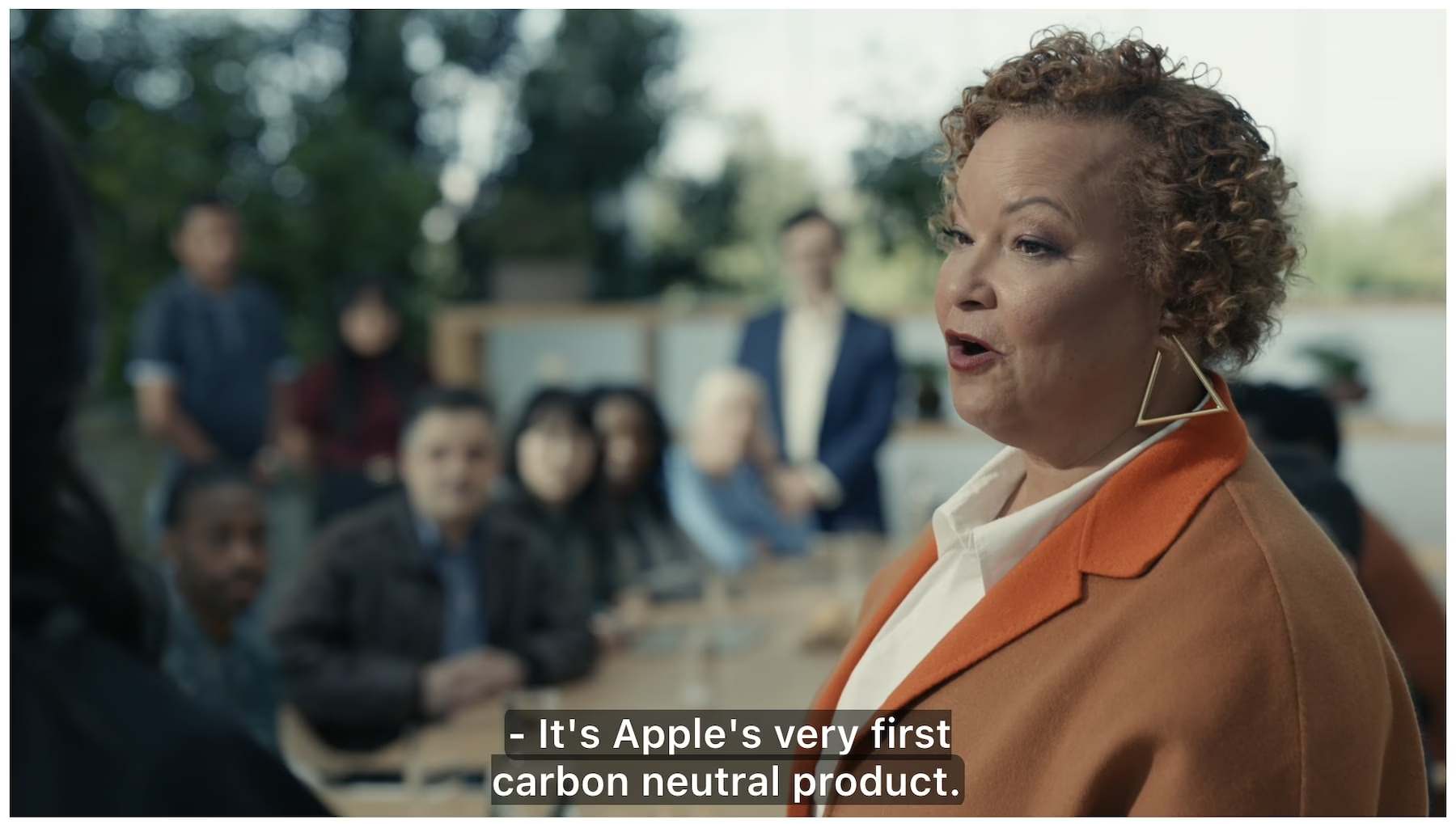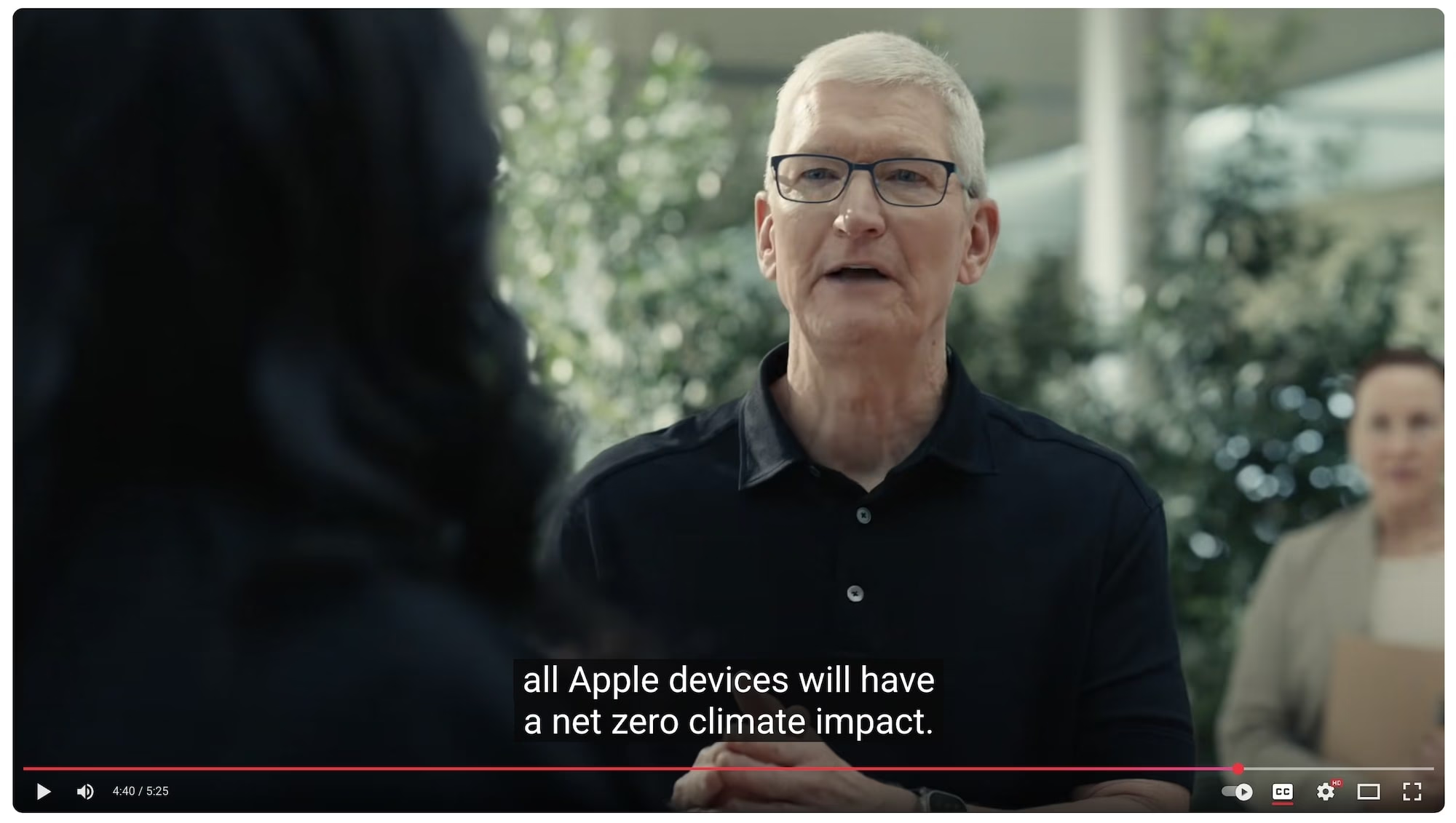In our new series, we take a look at the sustainability marketing strategies of global brands and outline how they could be better. For the first episode, it’s one of the biggest brands on the planet, which, despite massive marketing clout, doesn’t seem to be able to find the right line when marketing its sustainability. It’s a little perplexing.
That’s where we step in to make it more sensible, in theory.
Summary Points:
- Stop grandstanding (and greenhushing): Apple has swung between exaggerating its claims (like ‘carbon neutral’) and saying almost nothing at all. They need to find a confident, accurate middle ground.
- Make net zero 2030 a main event: The 2030 net-zero target – which includes their massive supply chain – is one of the most ambitious in the world and should be a bold, central story instead of lurking in the background.
- Ditch the slick perfection: The company needs to be more honest about where they have to improve, rather than presenting a hagiography of their environmental progress. This builds more trust than a façade of impeccable sleekness.
- Tailor the talk: A one-size-fits-all global approach for sustainability marketing doesn’t work. Claims that are fine in the US might be a turn-off in Europe, or even get banned. The tone needs a tad more regional tailoring, unlike the universal products.
- Stop hiding the good stuff: The strong sustainability details and narrative should be brought out of lengthy corporate reports and directly into fans’ touchpoints, like the Apple Stores and product pages.
Background:
Apple is a brand that needs no introduction and you’ve surely used one of its products. Actually, this post is being typed on one now (an iMac). Yet, despite the ubiquity of the brand, less is known about its sustainability, despite some purposeful movement in the area to substantiate a strong story. The company has one of the most ambitious net zero targets of any major global brand – aiming at 2030, which also includes its supply chain. Products have increasingly strong sustainability credentials, with growing use of recycled or even ‘regenerative’ materials. Supporting measures like the protection of Californian Redwood trees are being introduced every month.
Of course, Apple isn’t perfect – no brand is – but why do people know less about the good things the company is doing? Compared to a paragon like Patagonia, which only aims at net zero by 2040? You could argue it’s a conscious move to not detract from the successful products. But the clumsy, disjointed history suggests it’s more likely that the company just hasn’t found the right approach. That’s why people are also a little confused. And that’s only going to matter more over time.
What can be improved?
Apple has, in our view, gone to two extremes when marketing its sustainability and eco-credentials.
Extreme 1: Grandstanding – this is a common trap when brands bring their sustainability to market. And Apple falls into the trap by branding products as ‘carbon neutral’ or making other exaggerated claims about the impact of its products on the environment.
Take Apple’s Mother Nature video from 2023, which went viral but today, in a more mature market, looks a little like it’s overreaching. It’s a clever, well-produced video but lines like ‘Apple offices are already carbon neutral’, ‘we’ve planted forests’, and ‘all Apple devices will have a net zero climate impact’ are beginning to sound a bit shaky. In five years it’ll probably be like looking back at one of those awful old comedies that seems wildly inappropriate. In five months, even.

And it is also a legal issue today. Apple was banned from claiming carbon neutrality in Germany this year – in part because of questionable offsetting – and damaging publicity ensued. The company is now moving away from using the term completely but we’d have told them to cut that out years ago.
Extreme 2: Greenhushing – the more contemporary extreme, perhaps related to the legal case we’ve just mentioned, is where Apple has decided to not talk much about its sustainability at all. This absence was conspicuous at its September 2025 Event, where environmental innovations barely received a mention. Despite the event being billed as ‘awe dropping’ there were only some little drips about eco-friendly product features, like recycled aluminum. Easy to miss. But the precipitous drop in volume from the roaring about sustainability in previous years, was hard not to notice.
Beneath the overarching problems, there are other issues. If you step into a luminous Apple store – or check the Apple website – the sustainability story around products, which is strong when you check the details, is not attention grabbing. Minimalism may work with the products themselves but here it’s too hidden away. It’s not like these details are unimportant to Apple’s audience. As part of the research for this post, we visited an Apple store to investigate the sustainability messages that jumped out without having to rummage around. The result? We have nothing to say.
Apple has also aimed at net zero by 2030 – a hugely ambitious target that is way ahead of comparative companies. It also includes its byzantine international supply chain and is mostly dependent on emissions reductions. If you take a wider look at net zero pledges, the country with the most ambitious target in the world is Finland, aiming at 2035 (followed by Austria and Iceland at 2040). These targets are set so far into the future because becoming net zero is an extraordinarily difficult thing to achieve and nobody has officially achieved it yet. If you’re going to aim at such a momentous target – now only a few years away, which will flash by quickly – then you’d better back it up with a story to match. Non-fiction, of course.
Besides the net zero headline, there are other supporting measures that are potentially quite powerful. Just last month, the launch of a new direct investment project through Apple’s Restore Fund to protect and restore California redwood forests and support other nature-based projects across the U.S. and Latin America, was announced. There are myriad others. In fact, there’s so much going on when you take the time to look into it that we’ve just edited the post to add this link to Apple’s new $600m investment in renewable energy across Europe.
An improved strategy:
So how could Apple improve its sustainability communications? Look, this article isn’t going to offer an endless / questionable strategic deck or a fully-fledged strategy. We’re here to offer succinct points for improvement.
Some of these will be a challenge because they’re oppositional to what Apple’s accustomed to as a brand. Here the most pertinent, we feel:
- Resist grand claims like ‘carbon neutral’. This may be hard for a company that is used to breaking new ground but for a matter like sustainability, a sense of proportion is important.
- Be accurate, loudly. Instead of greenhushing, greenwashing, or grandstanding, speak confidently about the exact details.
- Bring net zero centre stage. Net zero by 2030 would be an outstanding achievement – especially considering the sudden explosion of emissions from AI. So if that’s an authentic journey that won’t get rerouted then bring it centre stage instead of hiding it in the background.
- Net zero or carbon neutral? Both are used in communications around 2030. They’re different things, so clarify.
- More honesty about improvements – perfection isn’t necessary. Which may be hard swallow for Apple’s sleek and impeccable form but the company’s environmental reports read too much like a hagiography. There’s little about the things that are not so good. This openness builds trust.
- Planned obsolescence has to be clarified and, more profoundly, improved. When looking at Apple’s sustainability story – this is a weakness and you could even say the antagonist. This baddie must be dealt with, which may involve changes that are more profound than marketing. Marketing’s a part of it though and talking more about product circularity could bring some balance to the narrative.
- Be light-hearted (and less slick). In fairness, this tone is already present in places, like the flashes of self-deprecating humour in the Mother Nature video. Continuing in this vein without the grand statements could get the message across better. Perhaps while being a bit less slick. It’s a bit jarring when you can sense the multi-million-dollar investment oozing from every frame of a video about sustainability.
- Bring sustainability into Apple Stores. Apple Stores are many folk’s experiential touchpoint with the brand and at the moment they’re totally lacking those subtle highlights.
- Politics is cyclical, sustainability is not. Are brands like Apple paying too much attention to the political zeitgeist and getting nervous? We’re not sure but, if so, we’d suggest putting that influence to one side completely. Be more resolute.
- Take a tailored approach to tone. In this sphere, what goes down in the USA won’t be swallowed in Europe, and vice versa. This is why carbon neutral claims could still be positively perceived in the US but in the EU, not so much. Apple’s products have universal appeal but sustainability marketing needs a little tailoring.
- Simplify environmental progress reports – making them less wordy. Only the most diehard will read what is essentially a book.

But first, any strategy needs a goal and what is that? Simply for Apple to become more recognized for its pioneering sustainability efforts and become a global reference point. That, while communicating sincerely and avoiding the pitfalls of greenwashing.
Remember, that should not mean losing any focus on the products. It’s about supplementing their greatness with other great messages. Meaning, even greater products.
Isn’t this all a bit… naive?
Yes, of bloody course it is! We’re not insiders at Apple where discussions about this topic are already happening – discussions that are far more incorporative of the company’s intricate plans and complexities. But is some of this relevant, also yes! Sometimes outsiders can see problems and solutions more clearly than those caught up in the everyday noise from the corporate machinery.
If anyone caught up in that noise at Apple, or at another company, reads this then feel free to take some direction, or even get in touch to have a conversation about it. And otherwise we hope this has been an enlightening dissection of sustainability marketing that we’re experiencing (or not) at a global scale.
Next time. Patagonia.
Only joking. We’re not sure yet.



Leave a Reply